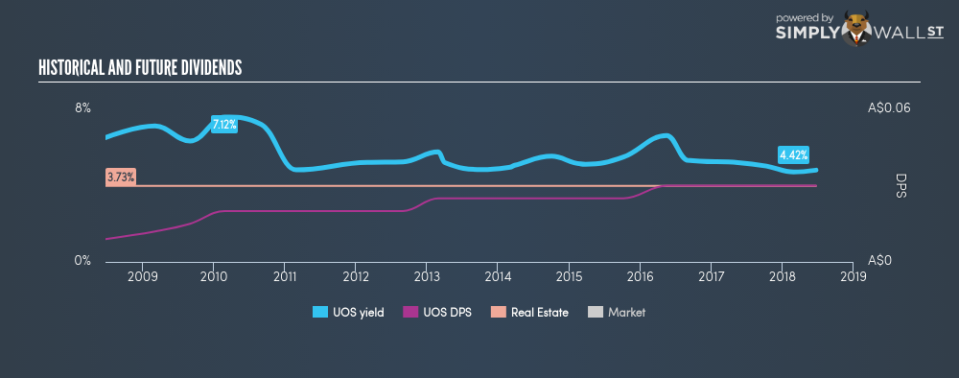Should You Buy United Overseas Australia Limited (ASX:UOS) For Its Dividend?

A sizeable part of portfolio returns can be produced by dividend stocks due to their contribution to compounding returns in the long run. Over the past 10 years, United Overseas Australia Limited (ASX:UOS) has returned an average of 5.00% per year to shareholders in terms of dividend yield. Does United Overseas Australia tick all the boxes of a great dividend stock? Below, I’ll take you through my analysis. View out our latest analysis for United Overseas Australia
Here’s how I find good dividend stocks
Whenever I am looking at a potential dividend stock investment, I always check these five metrics:
Is its annual yield among the top 25% of dividend-paying companies?
Does it consistently pay out dividends without missing a payment of significantly cutting payout?
Has dividend per share amount increased over the past?
Is is able to pay the current rate of dividends from its earnings?
Will it be able to continue to payout at the current rate in the future?
Does United Overseas Australia pass our checks?
The company currently pays out 36.72% of its earnings as a dividend, according to its trailing twelve-month data, which means that the dividend is covered by earnings. Furthermore, analysts have not forecasted a dividends per share for the future, which makes it hard to determine the yield shareholders should expect, and whether the current payout is sustainable, moving forward.
If there’s one type of stock you want to be reliable, it’s dividend stocks and their stable income-generating ability. UOS has increased its DPS from A$0.0090 to A$0.030 in the past 10 years. It has also been paying out dividend consistently during this time, as you’d expect for a company increasing its dividend levels. These are all positive signs of a great, reliable dividend stock.
In terms of its peers, United Overseas Australia produces a yield of 4.51%, which is high for Real Estate stocks but still below the market’s top dividend payers.
Next Steps:
Considering the dividend attributes we analyzed above, United Overseas Australia is definitely worth keeping an eye on for someone looking to build a dedicated income portfolio. Given that this is purely a dividend analysis, I recommend taking sufficient time to understand its core business and determine whether the company and its investment properties suit your overall goals. There are three important aspects you should further research:
Future Outlook: What are well-informed industry analysts predicting for UOS’s future growth? Take a look at our free research report of analyst consensus for UOS’s outlook.
Historical Performance: What has UOS’s returns been like over the past? Go into more detail in the past track record analysis and take a look at the free visual representations of our analysis for more clarity.
Other Dividend Rockstars: Are there better dividend payers with stronger fundamentals out there? Check out our free list of these great stocks here.
To help readers see pass the short term volatility of the financial market, we aim to bring you a long-term focused research analysis purely driven by fundamental data. Note that our analysis does not factor in the latest price sensitive company announcements.
The author is an independent contributor and at the time of publication had no position in the stocks mentioned.

 Yahoo Finance
Yahoo Finance 
